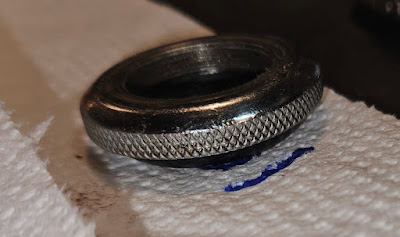If you've been working on old bikes, and particularly older British bikes, for awhile now, you probably have run into a case where you want to touch-up white paint (often on a rear fender). You probably tried "white" and found it actually did not match.
This is because there is a subtle and gradual fading that goes on with vintage white paint. What may have started out as "white" in 1950 or 60 from the factory may now be closer to an egg shell or even a cream type color. Sometimes there are subtle, mint green tones, or yellow tones, or even some staining.
Assuming the paint is in workable condition, I suggest starting with a light cleaning and polishing. You want to establish a "baseline" color and degree of gloss. I use NuFinish or similar car polish to bring out what the real color and gloss should be. I try to get the condition consistent across the entire part.
Next you need to start mixing your paint. I suggest a decent oil-based paint and I use the Testors model paints that come in the small glass bottles. They are inexpensive, easy to mix, and come in manageable quantities. You'll usually start with gloss, semi-gloss, or flat white, depending on how glossy your original paint condition is.
Take a disposable eye dropper and put a few drops (count them out) on mixing surface. Next, closely examine the original surface paint you are trying to match. Is it faded a little yellow? Or is it more of a mint green hue that has begun to come out? Does it have some tobacco type staining compared to your little pool of pure white paint? You'll have to decide.
Lighting here is important. I use two sources of light when trying to match paint: a cold, white colored LED accompanied by a regular incandescent type bulb. I find that LED tends to exaggerate difference in color not visible under a regular light bulb or even under sunlight. If it looks good under the LED, it tends to look even better outdoors.
Begin to mix in very small quantities of your tinting color. I usually have bottles of Testors light ivory (yellow tint), light brown (brown/tobacco type staining), and cream (yellow-pink tint) around. I start with less than a drop of my tint color - I usually take a tiny swipe with a very small brush and work it into the white. I keep tinting very gradually until I have a match of dry new paint to dry original paint.
Below is how I mix small quantities of paint. I use the clean bottom of a clear glass jar as a mixing surface. I keep a little paint thinner nearby to get the right thickness of paint. I keep my white and my "tinting colors" handy. Testors paints are designed to mix smoothly, and I think they're a great choice for this work.
Here's an extreme example: an all-white set of fenders that I'd like to put on a 1950s Raleigh Lenton. Most of the time, you're just touching up the lower part of the rear fender, but here the entire thing is white. They were in good condition to start with and touch-up has made them even better. These are steel fenders with original paint that has been touched up. In this case the tint was a very small amount of cream on the rear fender and a very small amount of brown on the front fender in stained areas. The result is not bad at all.






























